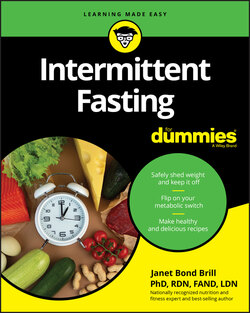Читать книгу Intermittent Fasting For Dummies - Janet Bond Brill - Страница 50
Doing the calculations
ОглавлениеYou can do the calculations and determine just how many daily calories you’ll need to take in and burn through exercise in order to create the calorie deficit needed (to lose weight safely). Or, if your goal is to maintain your weight, or even gain muscle mass, you can also calculate what a healthy calorie intake number would be.
Your calorie deficit shouldn’t be severe. You need to consume enough calories to function well, exercise, and stay healthy. Eating enough calories also helps maintain muscle mass during the weight-loss process.
The first step is to get an estimate of your daily calorie needs for maintaining your current weight. This depends on several factors:
Your age: Enter your age in years.
Your height: Enter your height in feet and inches.
Your current weight: Enter your body weight in pounds.
Your gender: Online calculators require you to input if you are a man or a woman. If you identify your gender as something other than man or woman, for the purposes of online calculations, choose the gender that most matches your body type.
Calculations of how many calories you need per day also require you to input your estimated activity level. Your activity level is generally categorized as follows:
Inactive: Never or rarely include physical activity in your day.
Somewhat active: Include light activity or moderate activity about two to three times a week.
Active: Include at least 30 minutes of moderate activity most days of the week or 20 minutes of vigorous activity at least three days a week.
Very active: Include large amounts of moderate or vigorous activity in your day.If you fall in the inactive category, I hope this lifestyle plan will help motivate you to move more — not only for the long-term weight loss maintenance benefits but also so you can tap into the significant health benefits an active lifestyle has been proven to provide.
The easiest way to estimate your calorie range is to use an online calculator. The Mayo Clinic has a simple calorie calculator at www.mayoclinic.org/ and search for calorie calculator.
After you have your estimated typical daily calorie needs from your current body weight and activity level, then you can use the Mayo Clinic calculator to see how many more calories you can eat if you increase your activity level. You can also get the big picture of how intermittent fasting reduces your calorie intake and promotes weight loss.
See how this is done using Kiki’s goals and activity level. Take Kiki’s stats from the previous section, and plug in her age (45), height (5-4), weight (150 pounds), and gender (female). Her activity level is somewhat active (Kiki walks her dog for 30 minutes three times per week).
Her estimated calorie needs are as follows: She needs to eat somewhere around 1850 calories per day (approximately 13,000 calories per week) to maintain her current weight.
One of the sad facts of life is that when you do lose weight, you need to recalculate the number of calories you can eat to continue your weight-loss journey spiraling downward, because a smaller body has a lower BMR. In other words, the skinnier you get, the less calories you can eat to continue losing weight. The good news is you can offset this by bumping up your activity level.
Consider Kiki again: She wants to lose 10 pounds, and she has chosen to practice the 5:2 intermittent fasting plan (on two nonconsecutive days in a week she confines her eating to one 500 calorie meal; refer to Chapter 12 for more about this plan). Assuming she continues to eat 1,850 calories on five days in a week plus her 1,000 calories (on her two fasting days) gives her a grand total of about 10,250 calories ingested in one week. If she continues with her current activity level, she’ll have created a calorie deficit of 2,800 calories per week (presuming she continues her 300 calorie burn per week from her dog walks). Kiki will lose about a pound a week — the recommended safe rate of weight loss.
Choose an approach to eating (don’t call it a diet — it’s a lifestyle) that best fits your personality. Part 3 discusses the different fasting plans you may want to consider. Whichever one you choose, ensure that your meals leave you satisfied, not hungry and definitely not deprived.
